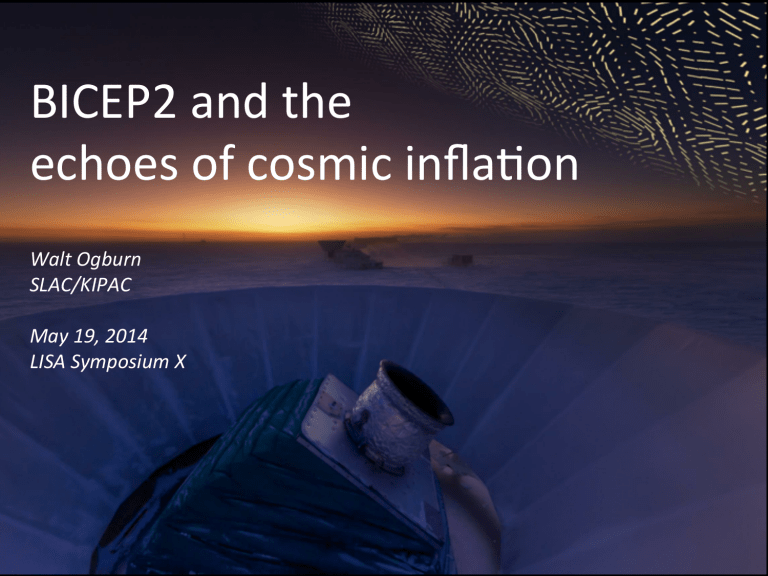Document 10441598

BICEP2 and the echoes of cosmic infla7on
Walt Ogburn
SLAC/KIPAC
May 19, 2014
LISA Symposium X
Walt Ogburn for the BICEP2 collabora7on LISA Symposium X, May 19, 2014
Walt Ogburn for the BICEP2 collabora7on LISA Symposium X, May 19, 2014
Walt Ogburn for the BICEP2 collabora7on LISA Symposium X, May 19, 2014
Cosmic Microwave Background (CMB)
The CMB traces the condi7ons of the universe at the 7me when
atoms first began to form.
Precision measurements of the
CMB temperature have provided a wealth of cosmological informa7on consistent with the infla7onary
paradigm.
However, any imprint of the infla7onary gravita7onal waves have so far eluded detec7on in the
CMB.
Planck Collabora7on & ESA
LISA Symposium X, May 19, 2014 Walt Ogburn for the BICEP2 collabora7on
CMB polariza,on: sca1ering from sound waves
e -
Walt Ogburn for the BICEP2 collabora7on LISA Symposium X, May 19, 2014
CMB polariza,on
Walt Ogburn for the BICEP2 collabora7on LISA Symposium X, May 19, 2014
E
B
CMB Polariza7on
E
B
The plasma physics of the early universe causes the CMB to become slightly
polarized.
Polariza7on can be described as the sum of E-‐modes and B-‐modes.
Only infla7onary gravita7onal waves can induce significant B-‐mode polariza7on on degree angular scales.
A measurement of degree-‐scale B-‐modes would be direct evidence for the gravita7onal wave background, free of the parameter degeneracies and cosmic variance inherent to temperature measurements.
LISA Symposium X, May 19, 2014 Walt Ogburn for the BICEP2 collabora7on
Search for B-‐modes
In simple infla7onary gravita7onal wave models
the tensor-‐to-‐scalar ra,o r
is the only parameter to the
B-‐mode spectrum.
Up to now: just upper limits from searches for B-‐modes
Polarbear
SPT x-‐corr
in the CMB polariza7on
Best limit on r:
r < 0.7 (95% CL)
At high mul7poles lensing
B-‐mode dominant.
SPT x-‐corr: lower limits on lensing B-‐mode from cross correla7on using the CIB
LISA Symposium X, May 19, 2014 Walt Ogburn for the BICEP2 collabora7on
“Holy grail” of cosmology?
Walt Ogburn for the BICEP2 collabora7on LISA Symposium X, May 19, 2014
…or a wild goose chase?
Walt Ogburn for the BICEP2 collabora7on LISA Symposium X, May 19, 2014
Walt Ogburn for the BICEP2 collabora7on LISA Symposium X, May 19, 2014
The Challenge
• Extremely faint signal demands a map that is...
•
Precise
Enormous raw sensitivity (10s of nK signal)
Approach photon noise limit
Many detectors ( multiplexing )
Observe from pristine site
•
Accurate
Rigid control of polarized systematics
•
Uncontaminated
Avoidance (or subtraction) of polarized foregrounds
LISA Symposium X, May 19, 2014 Walt Ogburn for the BICEP2 collabora7on
BICEP1 (2006-2008) BICEP2 (2010-2012) Keck Array (2011-2016) BICEP3 (2015-2016)
Walt Ogburn for the BICEP2 collabora7on LISA Symposium X, May 19, 2014
BICEP1 (2006-2008) BICEP2 (2010-2012) Keck Array (2011-2016) BICEP3 (2015-2016)
Walt Ogburn for the BICEP2 collabora7on LISA Symposium X, May 19, 2014
BICEP1 (2006-2008) BICEP2 (2010-2012) Keck Array (2011-2016) BICEP3 (2015-2016)
Walt Ogburn for the BICEP2 collabora7on LISA Symposium X, May 19, 2014
BICEP1 (2006-2008) BICEP2 (2010-2012) Keck Array (2011-2016) BICEP3 (2015-2016)
Walt Ogburn for the BICEP2 collabora7on LISA Symposium X, May 19, 2014
Focal p lane
“Polarimeter on a chip”
Planar antenna array
Transition edge sensor
Slot antennas
Walt Ogburn for the BICEP2 collabora7on
M icrostrip filters
LISA Symposium X, May 19, 2014
BICEP2 Sensi7vity
average:
Histogram shows per-‐detector noise equivalent temperature (NET) for data taken in 2012
Our recipe for high sensi7vity:
→ High op7cal efficiency
40% end-‐to-‐end
→
→
Cold op7cs
Low loading/photon noise
Low thermal conductance, and thus low phonon noise
High detector count
Total Sensi,vity for full BICEP2 instrument: 15.8 μK √s
Walt Ogburn for the BICEP2 collabora7on LISA Symposium X, May 19, 2014
“Telescope in a can”
Lens
Telescope as compact as possible while s7ll having the angular resolu7on to observe degree-‐scale features.
On-‐axis, refrac7ve op7cs allow the en7re telescope to rotate around boresight for
polariza7on modula7on.
Liquid helium cools the op7cal elements to 4.2 K.
A 3-‐stage helium sorp7on refrigerator further cools the detectors to 0.27 K.
1.2 m
Nylon filter
Lens
Nb magne7c shield
Focal plane
Passive thermal filter
Flexible heat straps
Fridge moun7ng bracket
Refrigerator
Camera plate
LISA Symposium X, May 19, 2014 Walt Ogburn for the BICEP2 collabora7on
Example:
FDS dust model
Observa7onal Strategy
Target the “Southern Hole” -‐ a region of the sky excep7onally free of dust
and synchrotron foregrounds.
Detectors tuned to 150 GHz, near the peak of the CMB’s 2.7 K
blackbody spectrum.
At 150 GHz the combined dust and synchrotron spectrum is predicted to be at a minimum in the Southern
Hole.
Expected foreground contamina7on of the B-‐mode power: r ≤ ~0.01.
LISA Symposium X, May 19, 2014 Walt Ogburn for the BICEP2 collabora7on
South Pole CMB telescopes
10m South Pole Telescope
BICEP1
BICEP2
BICEP3
DASI
QUAD
K eck
Array
A popular place for CMB Experimentalists:
Power, LHe, LN2, 200 GB/day, 3 square meals, Open Mic Night...
24h coverage of “Southern Hole”
Walt Ogburn for the BICEP2 collabora7on LISA Symposium X, May 19, 2014
South Pole CMB telescopes
10m South Pole Telescope
BICEP1
BICEP2
BICEP3
DASI
QUAD
Walt Ogburn for the BICEP2 collabora7on LISA Symposium X, May 19, 2014
BICEP2 3-‐year Data Set
on source aqer cuts
15.8 μK √s
87 nK deg
LISA Symposium X, May 19, 2014 Walt Ogburn for the BICEP2 collabora7on
BICEP2 3-‐year Data Set
on source aqer cuts
15.8 μK √s
87 nK deg
LISA Symposium X, May 19, 2014 Walt Ogburn for the BICEP2 collabora7on
Total Polariza7on
Walt Ogburn for the BICEP2 collabora7on LISA Symposium X, May 19, 2014
E-‐mode Signal
Walt Ogburn for the BICEP2 collabora7on LISA Symposium X, May 19, 2014
B-‐mode Signal
Walt Ogburn for the BICEP2 collabora7on LISA Symposium X, May 19, 2014
B-‐mode Signal
Walt Ogburn for the BICEP2 collabora7on LISA Symposium X, May 19, 2014
BICEP2 B-‐mode Power Spectrum
B-‐mode power spectrum es7mated directly from Q&U maps, including map
based “purifica7on” to avoid E→B mixing
Consistent with lensing expecta7on
at higher l.
At low l excesses over lensed-‐ΛCDM at high signal-‐to-‐noise.
For the hypothesis that the measured band
powers come from lensed-‐ΛCDM we find:
PTE: 1.3 × 10 -‐7
Significance: 5.2σ
B-‐mode power spectrum temporal split jackknife lensed-‐ΛCDM r=0.2
Walt Ogburn for the BICEP2 collabora7on LISA Symposium X, May 19, 2014
The Challenge
• Extremely faint signal demands a map that is...
•
Precise
Enormous raw sensitivity (10s of nK signal)
Approach photon noise limit
Many detectors ( multiplexing )
Observe from pristine site
•
Accurate
Rigid control of polarized systematics
Extensive instrument characteriza7on
Null tests, simula7on of systema7cs
•
Uncontaminated
Avoidance (or subtraction) of polarized foregrounds
Comparison with external dust+synchrotron maps
Spectral index constraint
Walt Ogburn for the BICEP2 collabora7on LISA Symposium X, May 19, 2014
Constraint on Tensor-‐to-‐scalar Ra7o r
Uncertain7es here include sample variance at r=0.2
best fit
Substan7al excess power in the region where the infla7onary gravita7onal wave signal is expected to
peak
Find the most likely value of the tensor-‐to-‐scalar ra7o r
Apply “direct likelihood” method, uses:
→ lensed-‐ΛCDM + noise simula7ons
→ weighted version of the 5 bandpowers
→ B-‐mode sims scaled to various levels of r (n
T
=0)
Within this simplis7c model we find: r = 0.2 with uncertain7es dominated by sample variance
PTE of fit to data: 0.9
→ model is perfectly acceptable fit to the data
Non-‐existence of infla7onary gravity waves r=0 ruled out at 7.0
σ
Walt Ogburn for the BICEP2 collabora7on LISA Symposium X, May 19, 2014
Compa7bility with Indirect Limits on r
Constraint on r with running allowed :
Walt Ogburn for the BICEP2 collabora7on
Indirect limit on r from combina7on of temperature data over a wide range of angular scales:
SPT+WMAP+BAO+H
0
: r < 0.11
Planck+SPT+ACT+WMAP pol
: r < 0.11
This apparent tension can be relieved with various extensions to lensed ΛCDM.
Example: running of the spectral index
Planck likelihood chains for lensed
ΛCDM + tensors + running
Same chains, importance sampled with the BICEP2 r likelihood
Other possibili7es within
ΛCDM?...
LISA Symposium X, May 19, 2014
Conclusions
BICEP2 and upper limits from other experiments: h1p://www.bicepkeck.org/bicep2_2014_release
Walt Ogburn for the BICEP2 collabora7on
Most sensi7ve polariza7on maps ever made
Power spectra perfectly consistent with lensed-‐ΛCDM except:
5.2σ excess in the B-‐mode spectrum at low mul7poles!
Extensive studies and jackknife test strongly argue against systema7cs as the origin
Foregrounds do not appear to be a large frac7on of the signal:
→ foreground projec7ons
→
→
→
lack of cross correla7ons
CMB-‐like spectral index
shape of the B-‐mode spectrum
Constraint on tensor-‐to-‐scalar ra7o r in
simple infla7onary gravity wave model:
r=0.20
+0.07
-‐0.05
.
With r=0 is ruled out at 7.0σ.
LISA Symposium X, May 19, 2014
Conclusions… so far
BICEP2 and upper limits from other experiments: h1p://www.bicepkeck.org/bicep2_2014_release
Walt Ogburn for the BICEP2 collabora7on
Most sensi7ve polariza7on maps ever made
Power spectra perfectly consistent with lensed-‐ΛCDM except:
5.2σ excess in the B-‐mode spectrum at low mul7poles!
Extensive studies and jackknife test strongly argue against systema7cs as the origin
Foregrounds do not appear to be a large frac7on of the signal:
→ foreground projec7ons
→
→
→
lack of cross correla7ons
CMB-‐like spectral index
shape of the B-‐mode spectrum
Constraint on tensor-‐to-‐scalar ra7o r in
simple infla7onary gravity wave model:
r=0.20
+0.07
-‐0.05
.
With r=0 is ruled out at 7.0σ.
LISA Symposium X, May 19, 2014


